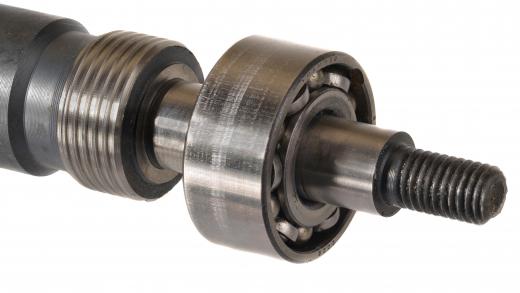A ball spline is a type of bearing that provides smooth and unrestricted linear motion. Consisting of steel ball bearings riding in deep-cut splines on a shaft, a collar, called a nut, also has splines machined into the interior that fits over the steel balls. The use of a ball spline allows the outer nut to slip freely back and forth over the shaft, while the balls that fit tightly between the shaft and the nut provide the connection and subsequent power transmitting between the shaft and the nut. The ball spline is a very common method of connecting a drive shaft to the transmission in powerful, late-model dirt race cars.
Unlike common splined shafts, the ball spline actually gets stronger when flexed to angles as great as 45 degrees. By placing the ball spline at an angle, the surface area of the balls contact more of the nut, so a stronger joint is maintained. In applications such as the driveshaft in a dirt race car, this is important due to the tendency of the drive shaft to be operated at angles as the car drifts through high-banked corners. Modern racing-suspension setup techniques also have the rear of the vehicle rising high into the air on a four-bar suspension system, creating an angle between the transmission and the drive shaft.

The use of ball spline shafts are also common in helicopter motor mounts. The linear motion allowed by the ball spline makes a smooth transition of power while allowing nearly friction-free linear movement at high speeds. Unlike a common-splined shaft, the ball spline has greater strength through the increased contact surface of the steel balls. The rolling contact of the steel balls also prevents backlash that is common in other splined shafts. This helps to achieve superior precision and reliability between the two parts of the splined shaft.
The strength of the ball spline comes from the exact fit between the steel balls and the machined grooves. With a traditional splined shaft, the torque is applied to the edge of the flat spline only. The steel balls have the pressure of the driving shaft distributed across a wide area of the ball, including the top, bottom and two sides. Under load, the power transmitted through the balls is divided among all of the balls in the spline, increasing the amount of power that the spline can withstand as well as providing a smaller and easier to turn package than a standard splined shaft.
